Native Son – July, 2012
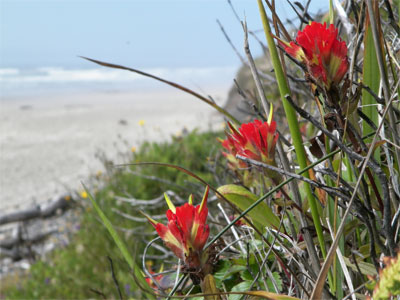
Coastal Indian Paintbrush at South Beach State Park. All photos by Steven Chamblee.
2,000 Miles from Texas
I read a quote on the Internet the other day — “A 50-year-old man who views the world like a 20-year-old man has wasted 30 years of his life.” I like that … reminds me that change is inevitable, and usually a good thing. It was attributed to Muhammad Ali, but that website also contained a quote from Abraham Lincoln: “You never really know for sure about a quote you read on the Internet.”
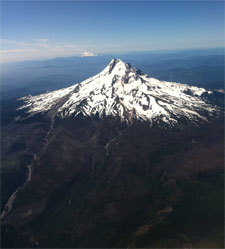
Mount Hood from 30,000 feet.
About two years ago, I took a trip to Oregon. I successfully packed everything but my reading glasses, so I bought a pricey pair at the airport. Luckily, I remembered to pack those same glasses on my trip back to The Beaver State this week. As I peek over them to view Mount Hood from the air, I wonder if Oregon has changed as much as I have in the last 51 fortnights. Change happens to us all, collectively and individually, but we all have a different metabolism for it. Some guys haven’t changed since Woodstock. Others evolve annually … with the football season. Me? Well, on any given day, my poor wife is never really sure who’s coming home from the garden.
Oregon is an interesting place: 2.000 miles from Texas, but the similarities strike me in the forehead like a well-aimed ball peen hammer. First off, the people from both places are very proud and independent. Good roads. An overall appreciation for the art of fishing. Other than that, well … you just have to look a little closer….
So I’m on the beach, looking at the magnificent Pacific Ocean in all its glory, when a little speck of orange over in the vegetation line catches my eye. Looks like the same rich hue you see blanketing the bar ditches all over Texas in April, but it’s ridiculous to think that an Indian Paintbrush has any business on the beach in Oregon, so I go check it out. Danged if it’s not a paintbrush all right, but how did it get here? Maybe some other Texan tossed some seed here just to spread the love. Nah. I whip out the trusty phone and Google up, “Castilleja Oregon coast.” Seconds later, I’m reading about Castilleja affinis, the Coastal Indian Paintbrush that’s native from Northern California up to the Columbia River. Here it is, July … but the temperatures are similar to the Texas springtime, so I guess it’s possible. I ponder the possibilities of common ancestry and regional adaptation for a few minutes until I spot a plastic bottle nearby, with the label in Japanese. I pick it up and walk over to the trash can, then see many others like it inside. Trash from Japan? The tsunami? Is that even possible? All of a sudden, the world seems a little smaller. I think about change again … sometimes we don’t choose it.
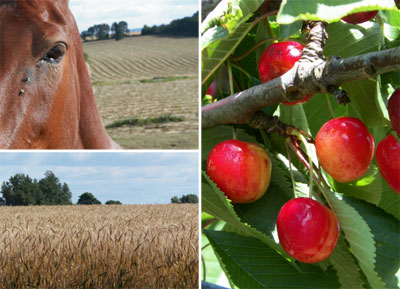
Top left photo: Horse and hayfield near Sheridan, Oregon. Bottom left photo: Wheatfield in the Willamette Valley. Right photo: Queen Anne cherries ready for picking.
Driving east, I pass through a change of ecosystems as I go from coastline almost immediately into the heavily forested coastal range of low mountains, then into the agricultural nirvana of the Willamette (“will-lamb-it”) Valley, where horses, hay, cherries, and berries reign supreme. The incredible Cascade Mountains lie just a few miles ahead, but right now it’s harvest time for all of the crops in the valley, and the haymakers are working dawn to dark. Roadside stands are everywhere, bulging with boysenberries, blueberries, blackberries, Marionberries, raspberries, and more varieties of cherries than I knew existed. Eventually I spot and stop at a tree so laden with cherries that I’m giggling like a five-year-old boy who tooted in church. The owner stops by to see what I’m doing, and I ask him if I can pick a quart of them off the tree myself. He hands me a large cardboard box and says, “Knock yourself out. They’re Queen Annes.” When I offer to pay, he just laughs and walks away, mumbling something about, “Don’t eat too many at one time or you’ll regret it later tonight.” I laugh and pick madly … one in the mouth, one in the box …one in the mouth, one in the box … for a good half hour. Bloated on cherries, I head off into the sunset, with visions of cherry-fairies swirling in my head. Shortly before midnight, I discover that man knew what he was talking about.
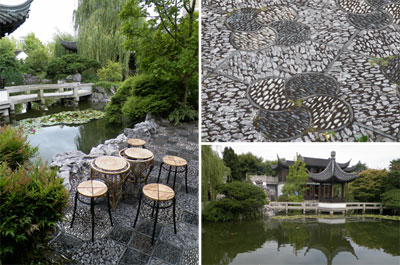
Lan Su Chinese Garden in Portland.
Next morning, I cruise up to Portland to visit the Lan Su Chinese Garden, located right in the heart of Chinatown. One city block; 20 years in the planning; 65 artisans from Suzhou spent a year assembling the authentic Chinese-crafted structures; amazing. Proper sentences cannot adequately express the power and beauty of this garden, so I will toss the words into the wind and let them land as leaves….Never-ending patterns hypnotize … the soft caress of blossoms … winged koi gently fly in still waters … moss pillows above and below … bamboo swishes … gravity ceases … sounds become options … serpentine breeze entwines … plodding transforms into prancing … minutes melt into moments … stone befriends … smooth becomes luster; rough becomes color … hearing is not listening … fragrance warms; touch cools … life begets life … walls unite both sides … river stones smile … skies float … nothing is always something … a leaf dies so a worm can live … feel the body breathe, the blood flow, the spirit rise … this is the only moment that really is — for all of us…. I am different now; the garden is in my heart. I choose this change.
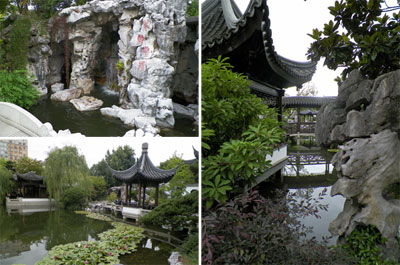
Lan Su Chinese Garden in Portland.
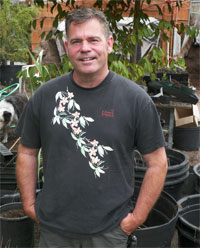
Cistus Nursery owner Sean Hogan in his element.
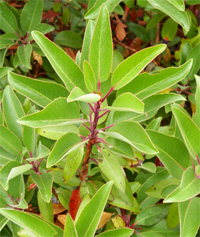
Texas Madrone.
Ten feet out the gate, the city returns. The meter maid still bustles about in a flurry, unaware of how much I have changed since she accosted me two hours ago … just seconds after I parked the car! But let us leave such trivial thoughts behind. I turn the key and sail my ship through asphalt waters, over mighty bridges, and past green meadows to Cistus Nursery, a cornucopia of botanical bliss over on Sauvie Island.
Greeted heartily by owner Sean Hogan, I am quickly blown away by the breadth and depth of his horticultural knowledge. Not one speck pretentious, he is simply a true man of the earth, both mentally and physically, and this is his domain. As we tour the nursery, he touches, pinches, pats, and encourages plants every inch of the way. It’s as if he is a musician, constantly fine-tuning an instrument.
Soon we come to a plant that looks very familiar to me. “Coastal Manzanita?” I ask. He grins broadly and says, “No. This is one of yours, though I collected the seed in Mexico.” I can’t believe it, but he confirms this is what folks in the Lone Star State call Texas Madrone (Arbutus xalapensis). I didn’t recognize it because it looks so…so…well, so healthy. I figured the soaking Oregon rains would kill it, since it is so persnickety about moisture and drainage. I have seen magnificent native stands down near Utopia, Texas, and huge specimens on rocky hillsides in Mexico, but have failed to keep one alive in a North Texas garden. In the wild, they are truly beautiful. The trunks are smooth, like crape myrtles, and the ruddy red bark peels away in sheets to expose the new pale white bark beneath, prompting the other common name, “Naked Lady.” Clusters of tiny white (sometimes pink), urn-shaped flowers adorn the tree in early spring, eventually developing into small edible fruit … no surprise for a member of the plant family Ericaceae, which includes blueberry, cranberry, and huckleberry.
Thirty hours later, I am at DFW Airport, struggling to wrangle my luggage and the bagful of plant souvenirs from Sean, when I get a text on my phone. I manage to corral my stuff to a corner, fish out my phone, and reach for my reading glasses. Not…in…my…pocket…. hmmm…where…could…they…be? After a moment of crazed patting and searching, I freeze with the sudden realization that they are still hanging right where I left them — in the magazine pouch, on the plane!
I suppose another trip is in order.
This article is dedicated to Blaine Wampler.
About the author: Steven Chamblee is the chief horticulturist for Chandor Gardens in Weatherford and a regular contributor to Neil Sperry’s GARDENS magazine and e-gardens newsletter. Steven adds these notes:
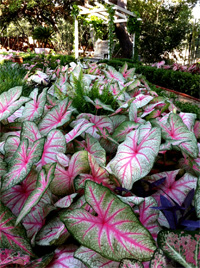
It may be hot outside, but the caladiums at Chandor Gardens are loving it! You really need to see them for yourself! Stay for lunch on Tuesdays and Wednesdays as The Wild Mushroom hosts lunch at the gardens. Reservations required — contact kelli, or call 817-374-2697. Adults: $16. Children’s menu available on request. For a peek at the menu, go to www.thewildmushroomrestaurant.com. Then just take I-20 west to exit 409, hang a right, go 2.1 miles and hang a left on Lee Avenue. Head straight 12 blocks and you’re driving in the gates. Call 817-361-1700 for more information. You can always visit the Chandor Gardens website for a picture tour and details.
I can always use another road trip! Let me know if you’d like me to come out and speak to your group sometime. I’m low-maintenance, flexible, and you know I like to go just about anywhere. No city too big; no town to small. Just send me an e-mail at schamblee@weatherfordtx.gov and we’ll work something out.

